1998 Quarter Coin Value: How Much Is It Worth?
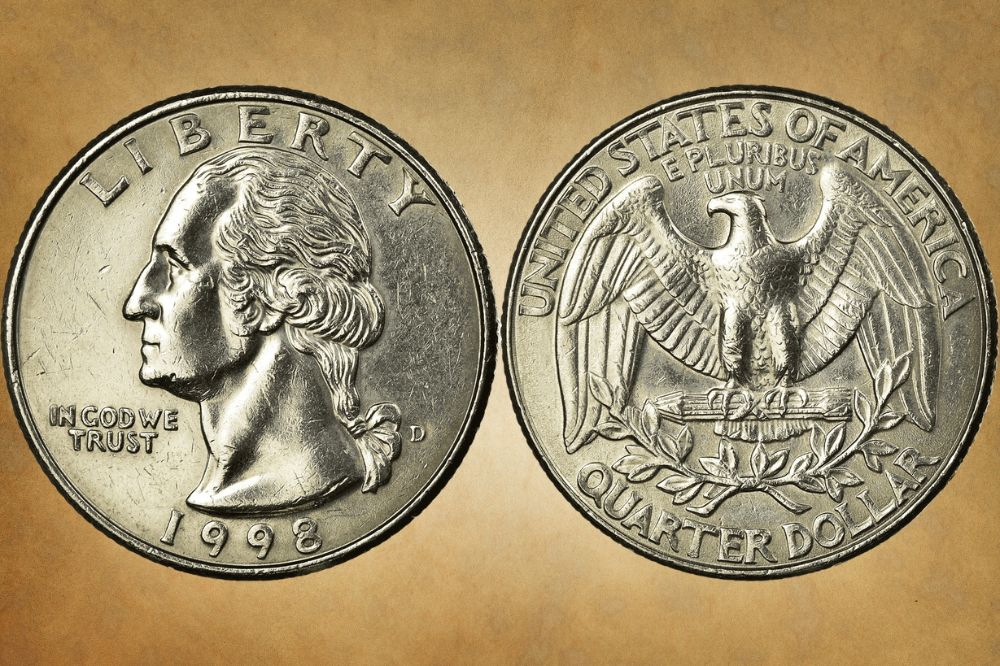
The Washington quarter is in a group of the longest-lived American coins, although its production began as a one-year commemorative coin. The idea was to pay tribute to George Washington, the first American President. Interestingly, this quarter was only the second US coinage in history with a genuine person shown on the obverse.
In most cases, modern quarters are not very popular among collectors, and you can count on higher demand for specimens minted in an earlier period. As expected, the 1998 quarter value is moderate, but you can expect prices to increase over time.
1998 quarter value Chart |
||||
| Condition | 1998 P quarter | 1998 D quarter | 1998 S clad proof quarter | 1998 S silver proof quarter |
| MS 65 | $7.88 | $7.88 | / | / |
| Proof 65 | / | / | $4.52 | $10.52 |
1998 Washington Quarter Value Guides
The US Mint released 1,720,233,299 Washington quarters into circulation that year. Three mints enabled such a high mintage, with the San Francisco mint issuing two proof coin types. One was a standard clad piece, and the other was made of silver.
1998 P quarter Value
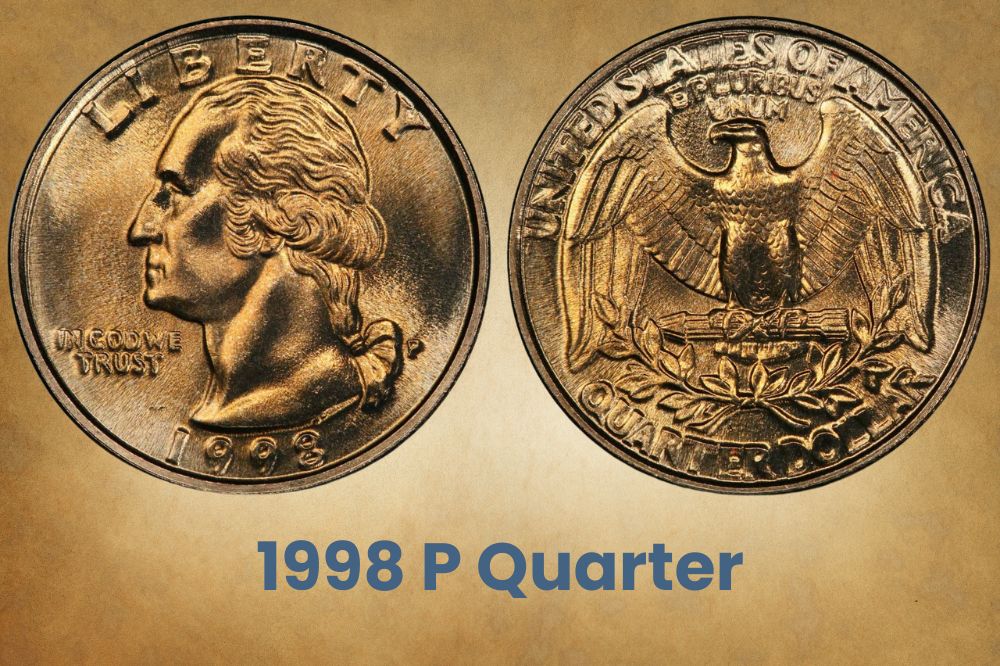
The Philadelphia mint issued the highest number of Washington quarters in 1998. More precisely, 896,268,000 pieces have the letter P on the obverse as a sign that they come from this particular mint.
Such a high circulation ensured the availability of these coins on the coin market and negatively influenced their value. Therefore, you can buy a circulated specimen for only $0.25. Well-preserved pieces in the mint state have slightly higher prices, and they can cost you approximately $8.
An auction is undoubtedly the best way to sell collectible coins. For example, one owner sold his 1998 Washington quarter graded MS 68 for $1,380 at auction in 2007.
1998 D quarter Value
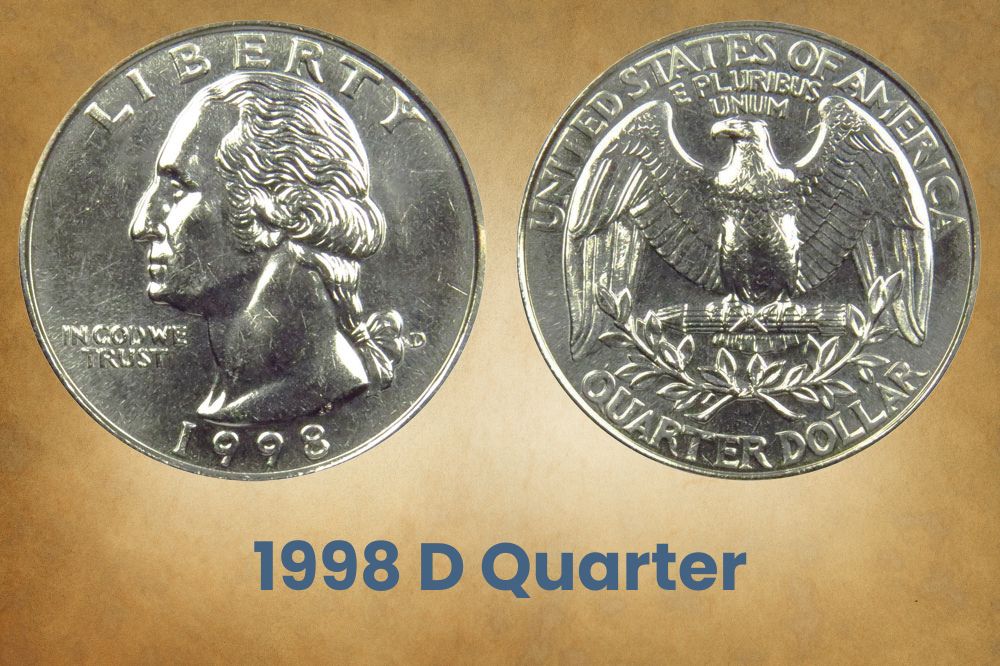
The mint in Denver released slightly fewer 1998 Washington quarters than the one in Philadelphia, 821 million to be exact. Thanks to the D mark, you can effortlessly distinguish them from other coins.
When some quarters are abundant, their value is low because high mintage negatively affects their prices on the coin market. Therefore, you can expect the cost of an average preserved piece to be similar to its face value. On the other hand, you can buy a well-preserved coin in the mint state for $8.
As expected, the situation can be different at auctions. For instance, one collector paid $1,528 for the 1998 D MS 67+ quarter at an auction in 2015. On the other hand, the 1998 D proof-like quarter graded MS 67 was sold on eBay for only $375.
1998 S clad proof quarter Value
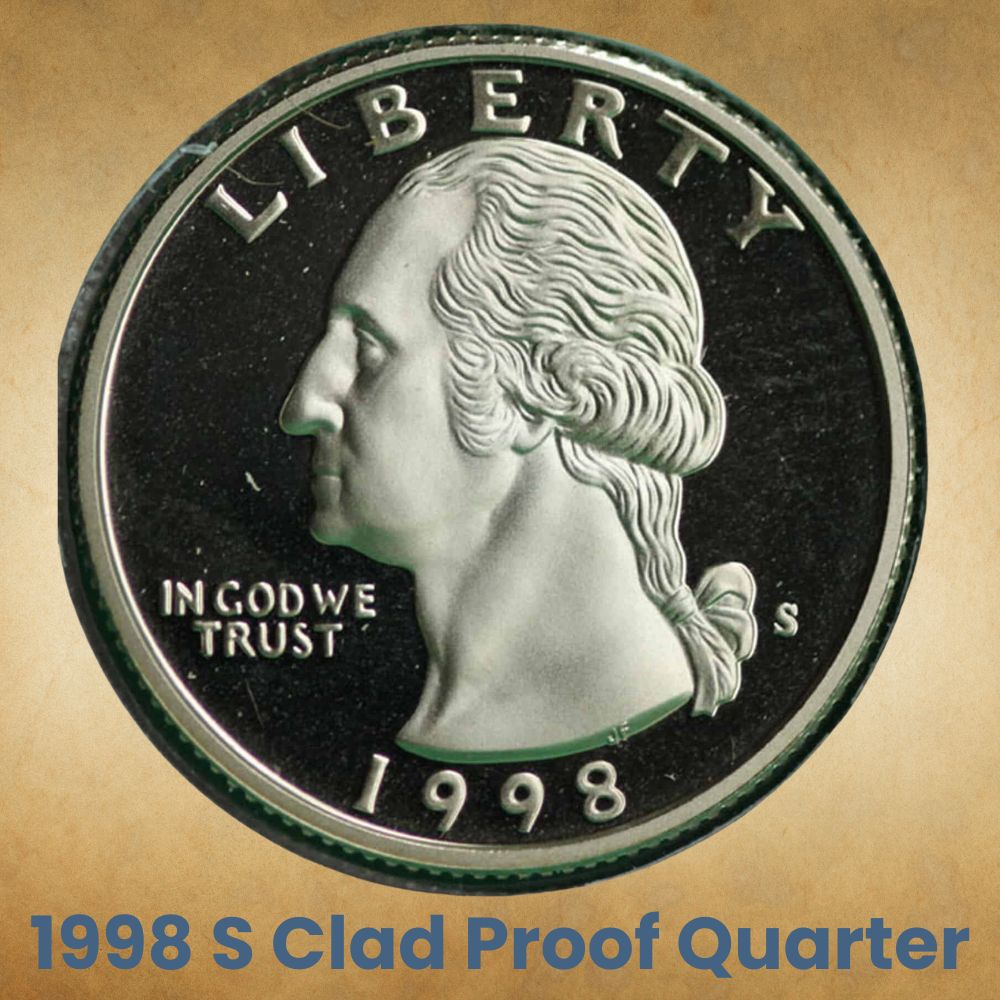
The San Francisco mint only produced proof Washington quarters this particular year but in two varieties. Collectors had 2,086,507 clad coins at their disposal, recognizable after the S mark.
Although one could logically expect these coins’ value to be high due to such a low circulation, it is not the case in practice. Currently, the value of the 1998 S clad Washington quarter proof is insignificant on the coin market and ranges from $1 to barely $12 for DCAM specimens.
There is no opportunity for a high profit even when selling these coins at auctions. The DCAM 1998 S PR 70 quarter won the current record after it sold for a modest $219 in 2005.
1998 S proof Washington quarter value |
||
| Condition | 1998 S clad proof DCAM quarter | 1998 S silver proof DCAM quarter |
| PR 67 | $1 | $8 |
| PR 68 | $3 | $9 |
| PR 69 | $5.5 | $12 |
| PR 70 | $12 | $32 |
1998 S silver proof quarter Value
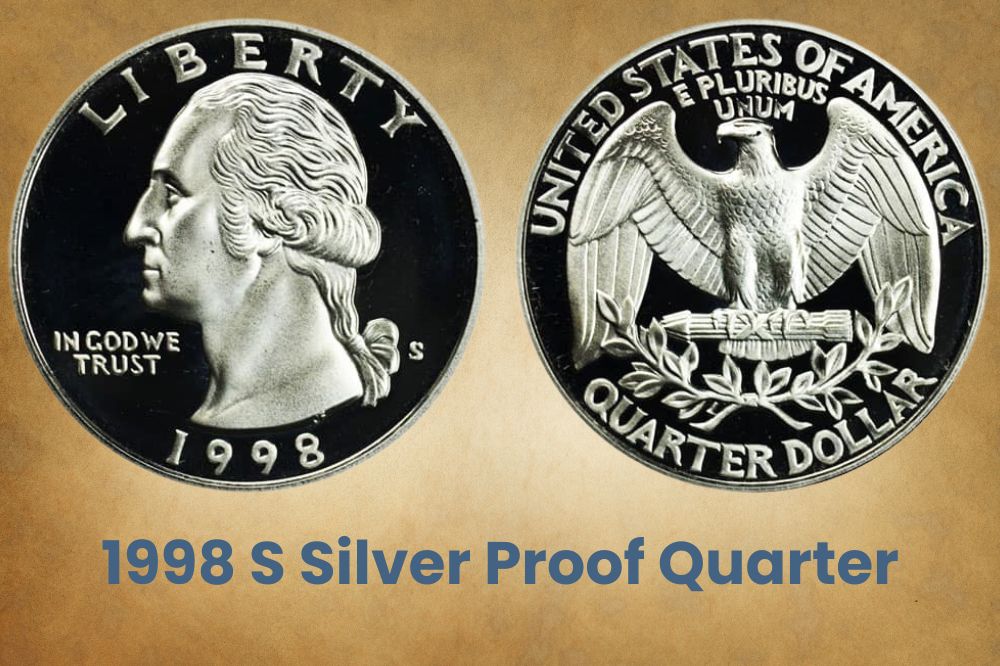
The US Mint offered the first unique option of silver coin proofs for collectors in 1992. By 1998, they could purchase proof sets made of 90% silver. The San Francisco mint produced 878,792 silver proof quarters that year, but a low mintage didn’t affect their value.
Believe it or not, most of these pieces cost approximately $8 to $32. Even the auction records are pretty modest. For instance, the most costly 1998 S PR 68 silver quarter with DCAM was sold for $930 at an auction in 2021.
Related Posts: 17 Most Valuable Modern Quarters Worth Money
1998 Washington Quarter Errors
By modernizing the production process, the US Mint gives its best to reduce the error coin existence. Despite all attempts, errors are still present, although their frequency is lower than before. On the other hand, collectors enjoy looking for such coins and have already found a few such Washington quarters from 1998.
1998 Washington Quarter Die crack
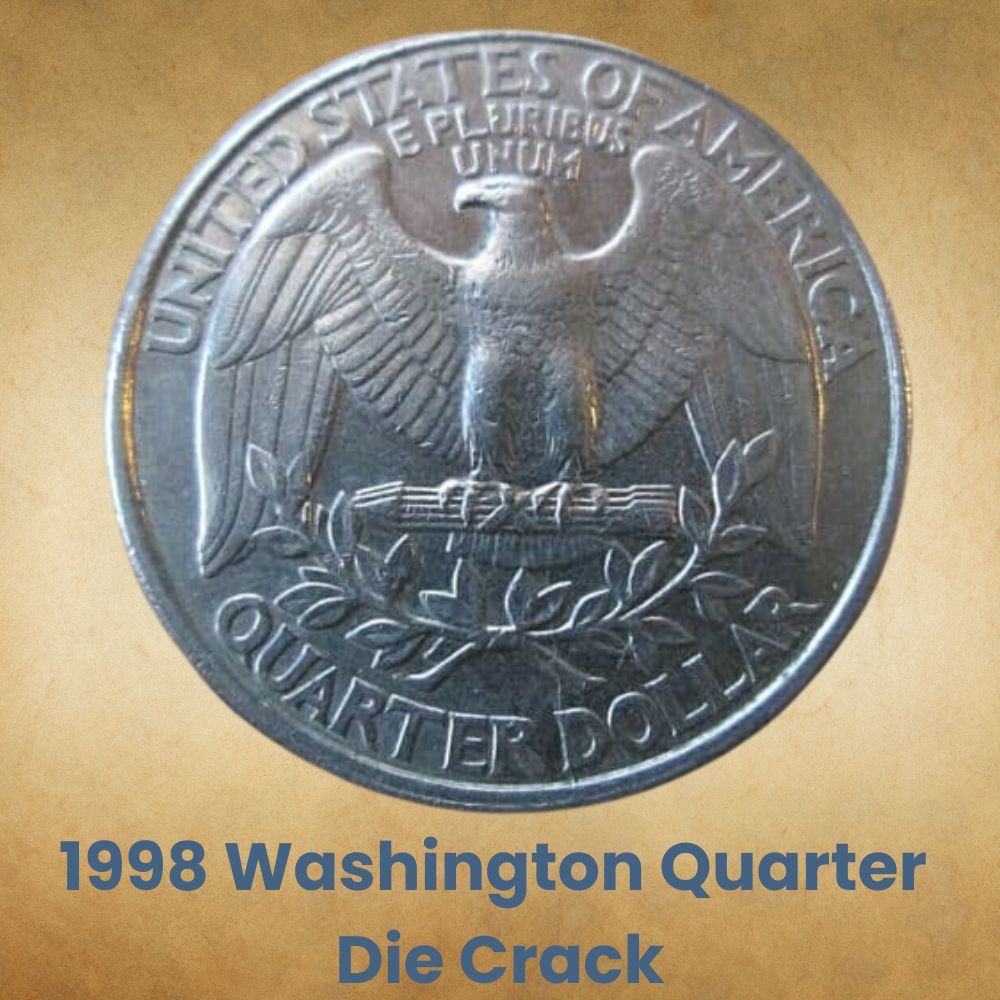
As you can guess, the dies suffer enormous pressure during minting and crack over time. As a result, you can notice tiny fissures created on their surfaces.
After filling with metal during the minting process, the impact of the die damaged in this way leaves small bumps on the coin surface. Be aware that the more pronounced bumps increase the error coin value.
1998 Washington Quarter Doubled die
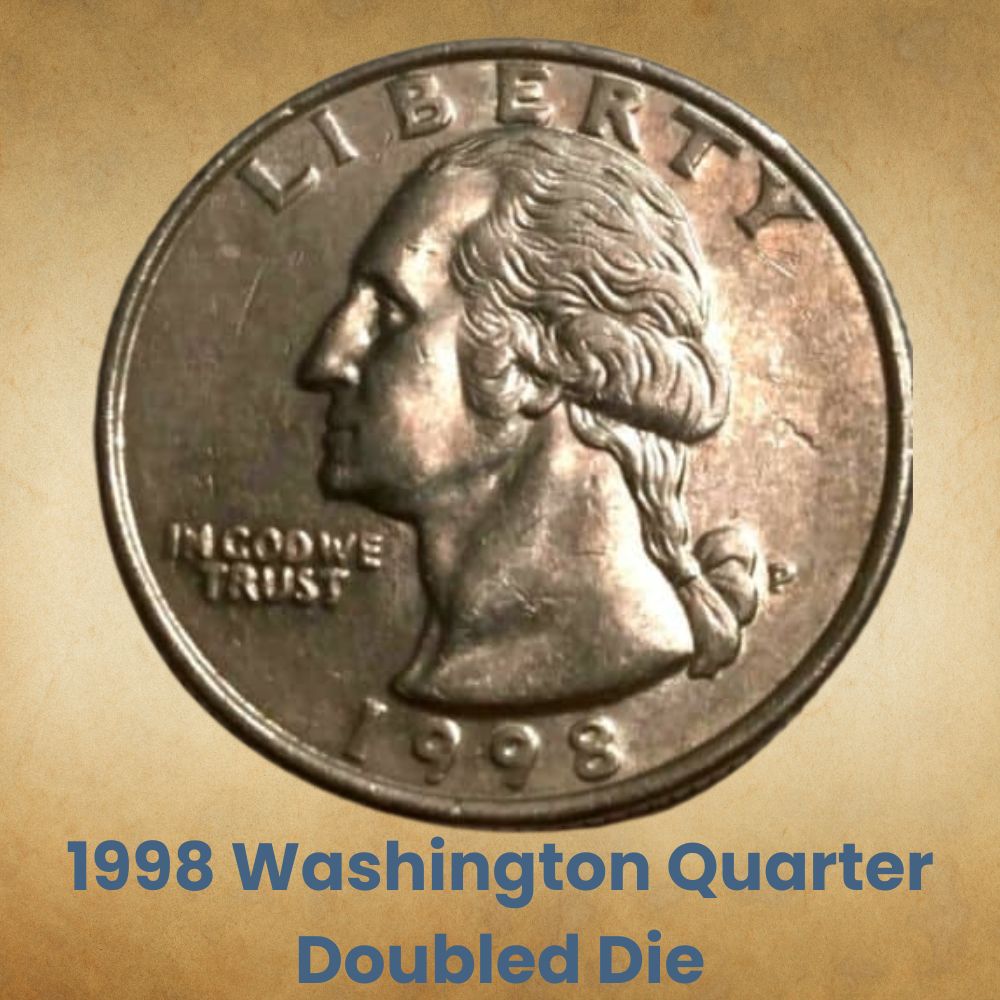
A doubled die is one of the most common errors you can find. It appears when the die hits the same coin two or three times. During this process, specimens with duplicated design parts occur.
You can find specimens with doublings on various coin parts, such as mint marks, numbers, and letters. The 1998 Washington quarters with this error reach up to $450.
1998 Washington Quarter Lamination
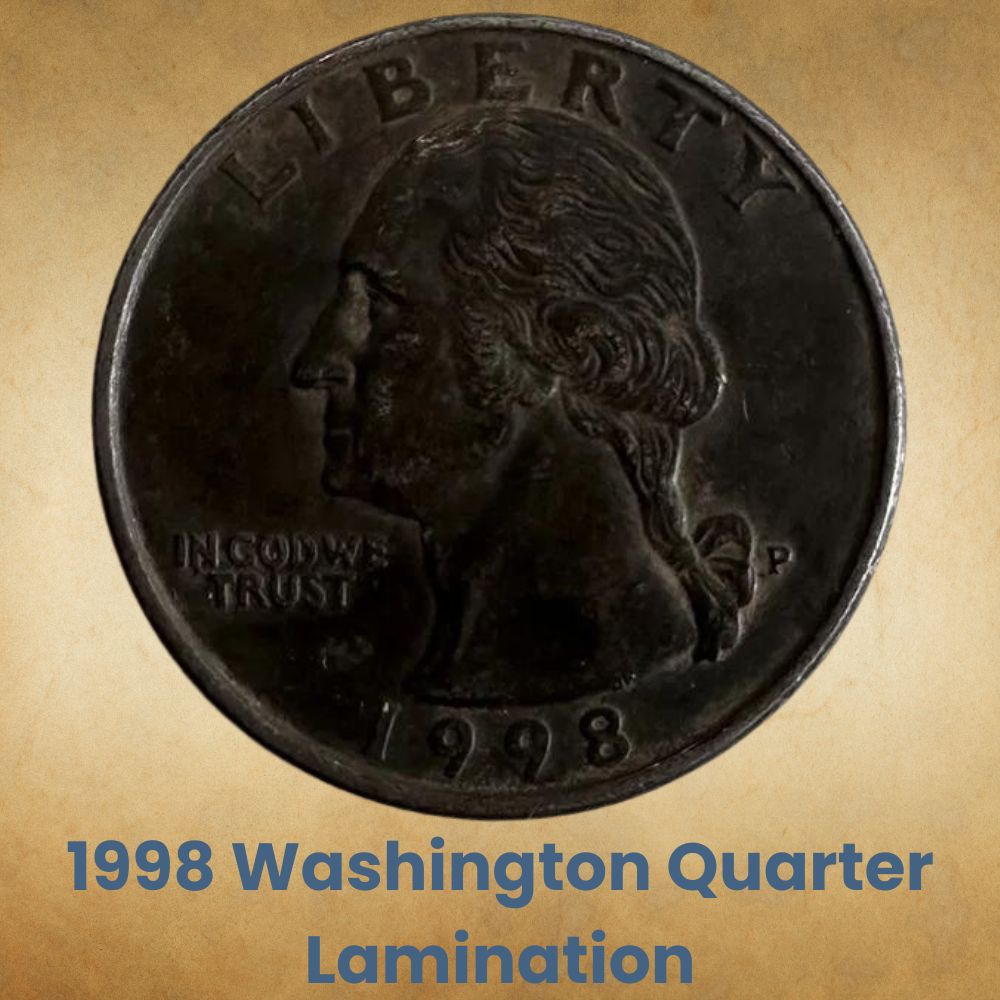
With this error type, you can notice the coin surface peeling or cracking because of contaminants in the alloy. In most cases, they cause the metal to separate, and visible consequences develop before or after the strike. Prices for these quarters range around $250.
1998 Washington Quarter Quarter struck on a five-cent planchet
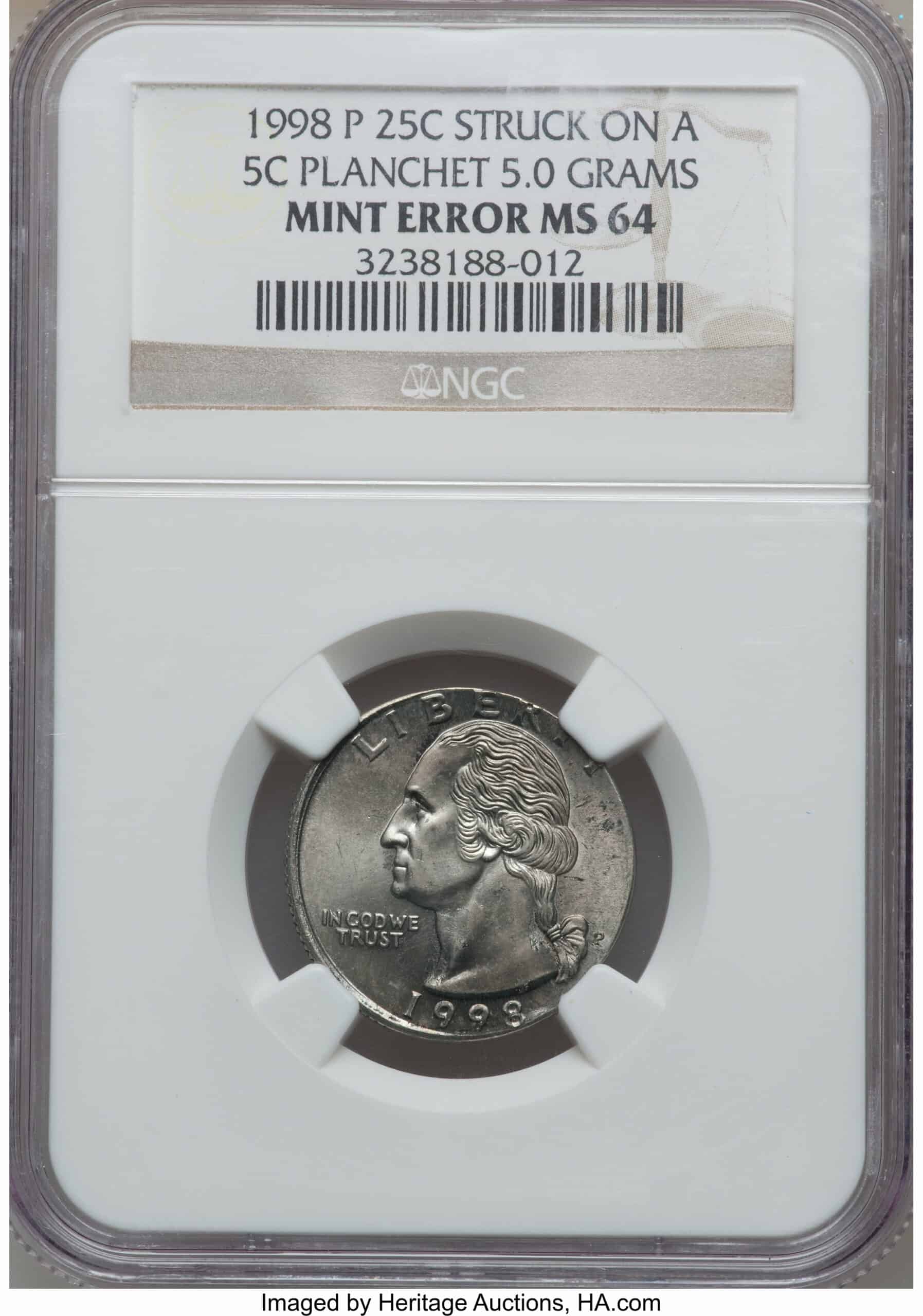
In sporadic cases, you can find the 1998 quarter with the D or S mint mark struck by mistake on a five-cent planchet. Even though these unusual coins are rare, don’t expect to earn too much on them. Their price ranges between $180 and $210.
1998 Washington Quarter Broad strike
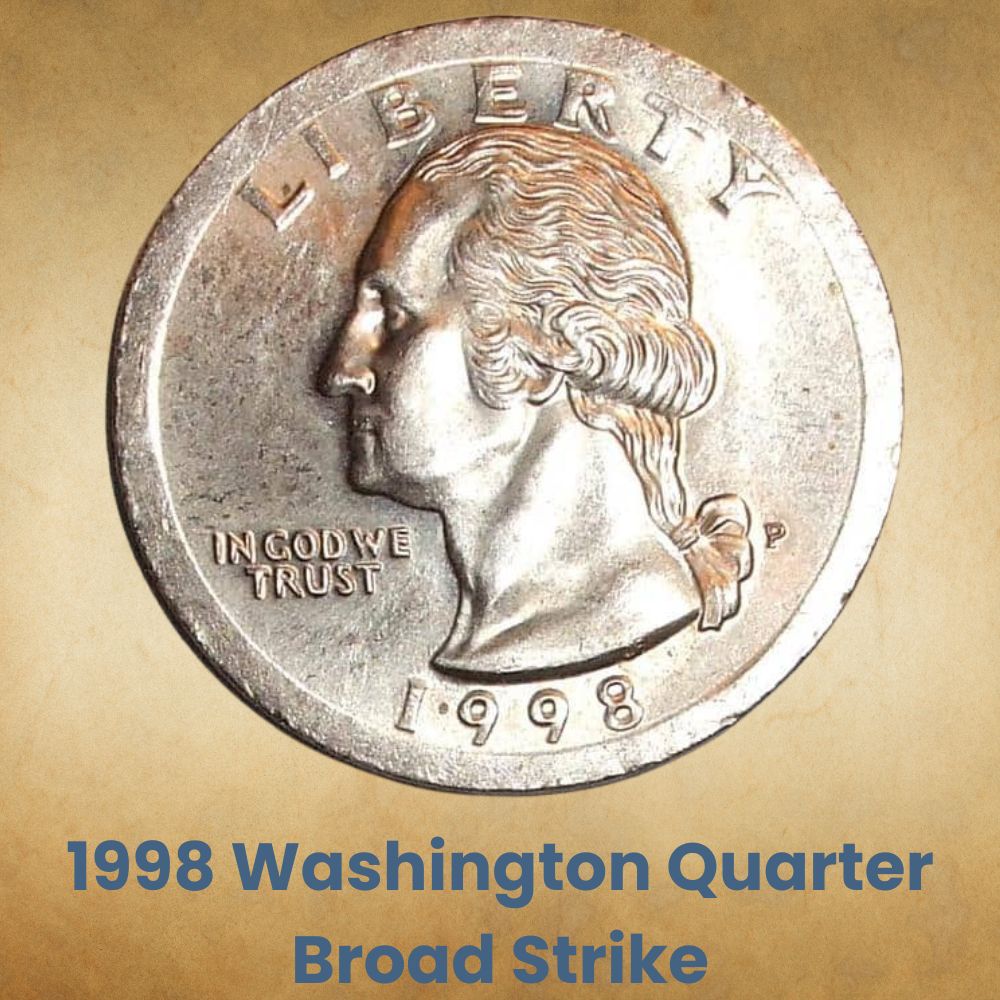
This imperfection results from the damaged collar that should prevent the metal from expanding upon impact to form a coin rim and edge. Such pieces are always wider than regular ones and often come with almost unreadable inscriptions near the rim while the edge is smooth.
1998 Washington Quarter Capped die
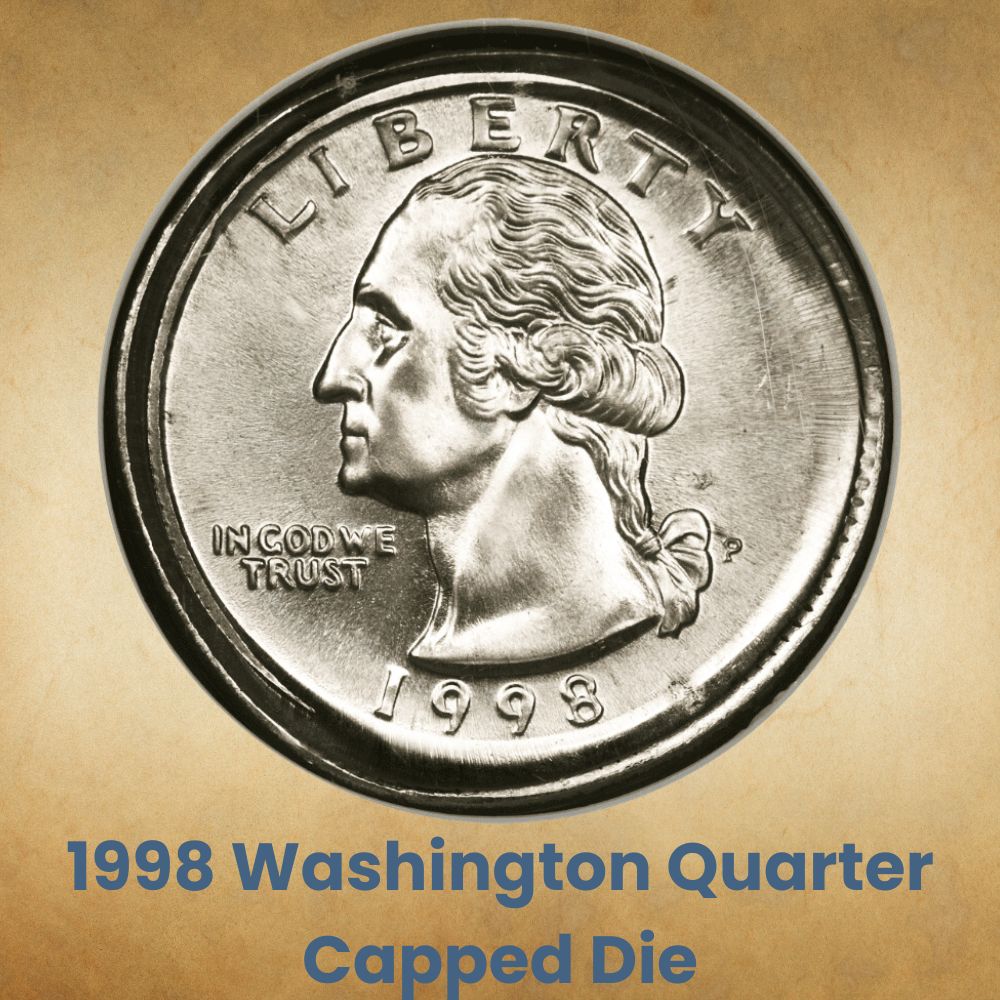
This error occurred when metal stuck to a die while it continued hitting new coins. In such a case, the planchet attached to the die took the shape of a bottle cap after a while. Because of this shape, damaged coins were named Capped die, while some collectors call them Mushrooms.
Related Posts: 16 Most Valuable Quarter Errors
The 1998 Washington Quarter History
As the bicentennial of George Washington’s birth approached, Congress decided it was time to mark the occasion. Preparations began in 1924, although the target year was 1932. The first step was establishing an American commission to celebrate the bicentennial.
The commission was relatively inactive before Herbert Hoover replaced Calvin Coolidge in the White House in 1929. In February of that year, a new committee was organized.
Congress presented a design for the coin to Hoover, but he rejected the preposition. His concern was possible opportunities for counterfeiting since the number of new coin designs created in the 1920s was high.
Another concern was the decreasing need for coins due to Great Depression. During this time, some coins had low mintages of several thousand pieces, which didn’t contribute to the commemorative quarters’ release.
Despite Hoover’s opinion, the Committee decided to open a competition for the new coin. They requested the obverse design to show the Washington bust and one of the national symbols on the reverse.
1998 Washington quarter |
||
| Location | Year | Minted |
| Philadelphia | 1998 P quarter | 896,268,000 |
| Denver | 1998 D quarter | 821,000,000 |
| San Francisco | 1998 S clad proof quarter | 2,086,507 |
| San Francisco | 1998 S silver proof quarter | 878,792 |
| Total | / | 1,720,233,299 |
The Committee consulted the Commission of Fine Arts and they agreed that Laura Gardin Fraser‘s design featuring Washington’s bust facing right was the best solution. As required by the law, the Secretary of the Treasury had to sign off on the choice.
Andrew W. Mellon ignored expert opinion and selected John Flanagan’s coin design instead. Some officials speculate that he rejected Laura’s ideas only because she was a woman.
Unfortunately, Flanagan’s design didn’t work out well primarily because the motto IN · GOD · WE · TRUST was barely visible and readable on the quarters minted from 1932 to 1934. The details on Washington’s hair also wore out quickly, making it necessary to modify the design. Despite all problems, the US Mint still produces these coins.
Related Posts: Top 10 Most Valuable Bicentennial Quarters Worth Money
How to Identify 1998 Washington Quarter?
Although they have changed their original composition, the Washington quarters have kept their appearance the same since the first minted pieces in 1932. The design was changed only in 1999 when the US Mint started producing new quarter sets.
The 1998 Washington quarter obverse
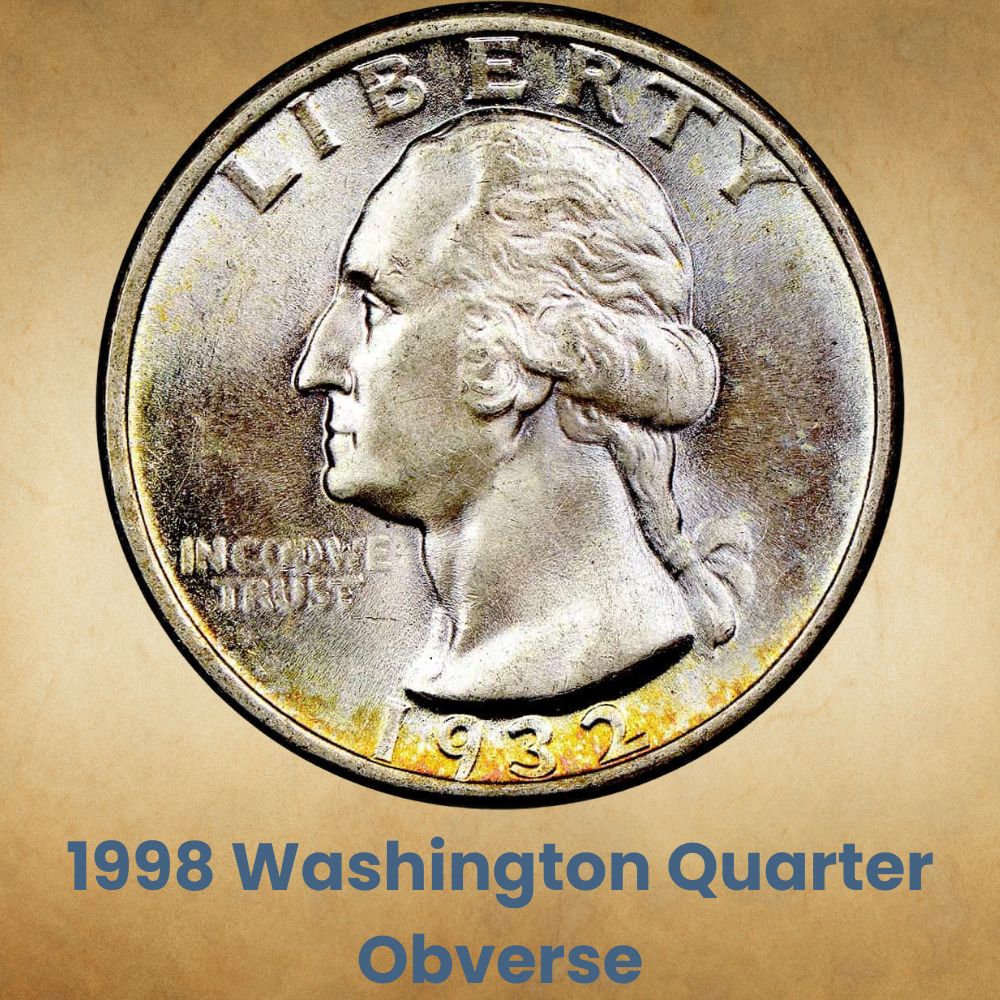
In the coin center, you can see the bust of one of the Founding Fathers of America and the first US President. His portrait is depicted simply with no unnecessary accessories.
Above his head is the word LIBERTY stretched along the coin’s upper rim. You can find three different marks right beside the bow in his hair, including:
- D for Denver
- P for Philadelphia
- S for San Francisco
Directly in front of the bust on the coin’s left side is a phrase IN · GOD · WE · TRUST. The obverse also contains the minting year going along the lower rim, just below the central depiction.
The 1998 Washington quarter reverse
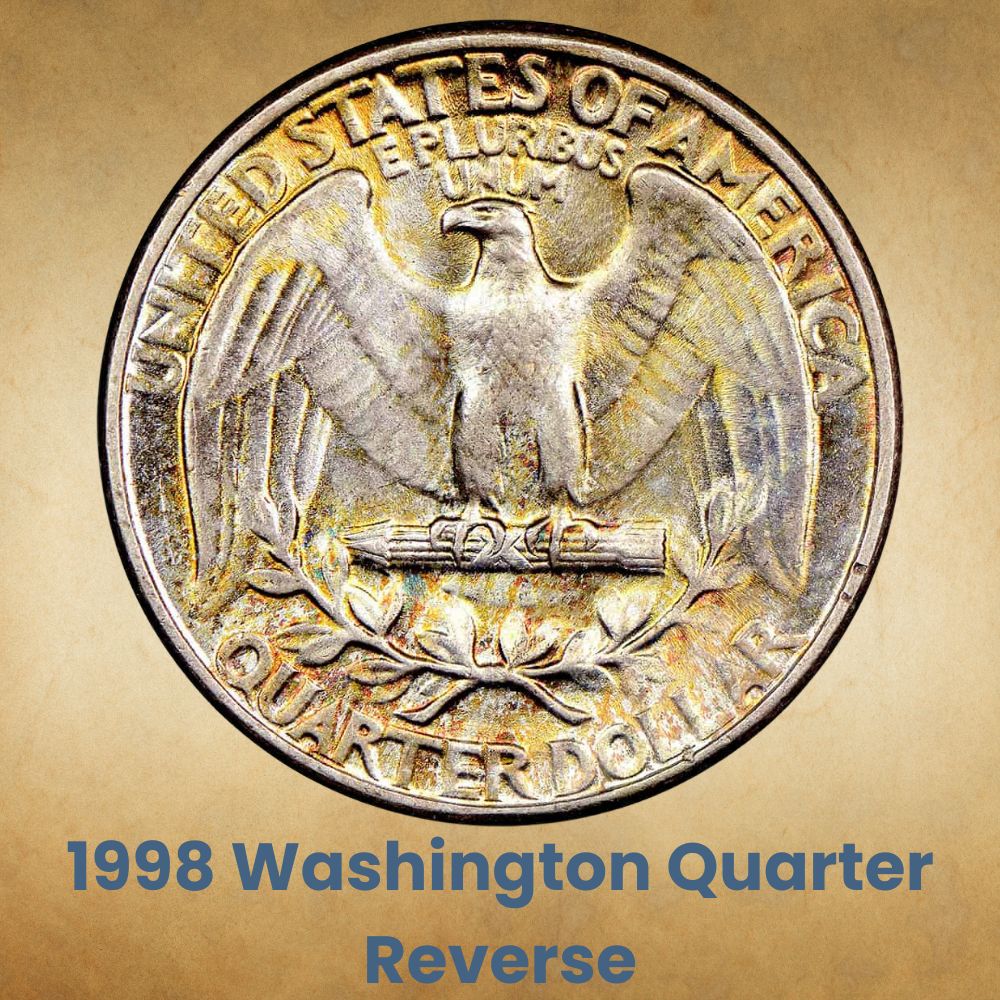
On the reverse center is one of the national symbols of America. You can see a bald eagle with its head facing left and spread wings. It firmly holds an arrow bundle with both claws, an ancient symbol of war. Below its talons, you can find two crossed olive branches as a symbol of peace.
Just below these branches is the denomination QUARTER DOLLAR, while E · PLURIBUS · UNUM is between the eagle’s wings. Along the upper rim is the country’s name.
1998 Washington quarter |
|
| Face value | $0.25 (25 cents) |
| Shape | Round |
| Coin diameter | 0.957 inches (24.29 millimeters) |
| Compound | Copper and nickel clad coin with a copper core |
| Coin weight | 0.200 ounces (5.68 grams) |
| Coin thickness | 0.069 inches (1.76 millimeters) |
| Edge | Reeded |
Other specific 1998 Washington quarter features
The 1998 Washington quarter is composed of a cupronickel alloy in a total 75% and 25% ratio. It is round with a reed rim, while its weight is 0.200 ounces (5.68 grams). The coin has a standard thickness of 0.069 inches (1.76 millimeters) and a diameter of 0.957 inches (24.29 millimeters).
Related Posts: 20 Most Valuable State Quarters Worth Money
What makes a 1998 quarter Rare?
The US Mint minted over 1,7 billion quarters in 1998. With such a high circulation and recent minting year, we can’t consider these coins rare. Unfortunately, no particular quality sets these coins apart from others in the series, making them abundant on the market and common for now.
Which 1998 quarter is most valuable?
- The 1998 D MS 67+ quarter ($1,528 at Heritage Auctions in 2015)
- The 1998 P MS 68 quarter ($1,380 at Heritage Auctions in 2007)
- The 1998 S silver PR 68 with deep cameo contrast ($930 at Stack’s Bowers auction in 2021)
- The 1998 D MS 67 PL quarter ($375 on eBay in 2022)
- The 1998 S PR 70 quarter with deep cameo contrast ($219 at Heritage Auctions in 2005)
How much money can you get for the 1998 P quarter?
The high mintage of the 1998 quarter from Philadelphia enabled these coins’ abundance on the market. So, their prices in average condition don’t exceed their face value.
However, mint-condition coins are more expensive, and their value is close to $8. Surprisingly, one of these pieces appeared at auction and sold for $1,380.
What is the most costly Washington quarter?
Washington quarters are among the oldest existing American coins in use since their production began in the early 1930s. Therefore, finding pieces from the early period in mint condition can be challenging, making them sought-after among collectors.
The rarest and most pricey is the 1932 D Washington quarter, which sold at an auction for a record $143,750. On the other hand, the most pricey quarter from 1998 was sold for $1,528 in 2015.
Related Posts: 21 Most Valuable Quarters In Circulation
